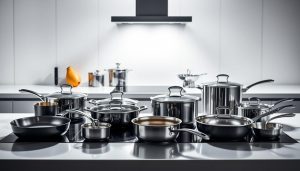Over 600 flavor compounds emerge from a single chemical process responsible for the golden crust on your steak and the rich aroma of fresh coffee. This transformative event isn’t magic—it’s science at work in your kitchen every time you cook.
Named after French chemist Louis Camille Maillard, this browning phenomenon occurs when heat triggers amino acids and sugars in food to interact. Temperatures between 280°F and 330°F spark the creation of melanoidins—molecules that deliver both color and complex tastes. Unlike caramelization, which only breaks down sugars, this reaction requires proteins to generate its signature savory depth.
Mastering this process elevates everyday cooking into an art form. Whether you’re roasting vegetables or grilling burgers, controlling heat levels determines whether you’ll achieve crispy perfection or burnt disappointment. For a deeper dive into how chemistry shapes your meals, explore our guide to the science of food and cooking.
Key Takeaways
- Occurs when amino acids react with sugars under high heat (140-165°C/280-330°F)
- Creates hundreds of flavor compounds absent in raw ingredients
- Produces distinct results in different foods due to varying protein and sugar combinations
- Differs from caramelization by requiring both amino acids and reducing sugars
- Responsible for the appealing color and aroma in baked goods, roasted meats, and brewed coffee
- Optimal temperature control separates professional results from amateur mistakes
Foundations: What Is the Maillard Reaction?
The science behind crispy bread crusts and savory meats began with a 20th-century breakthrough. In 1912, a French chemist observed amino acids bonding with sugars under heat while studying protein synthesis. His accidental discovery laid the groundwork for understanding why cooked foods develop rich aromas and golden-brown surfaces.

Decades later, USDA researcher John E. Hodge mapped the complex chemical dance. “These reactions build flavor like musical notes form a symphony,” he noted in 1953. Three critical elements drive the process:
| Component | Examples | Role |
|---|---|---|
| Reducing Sugars | Glucose, lactose | React with amino acids |
| Amino Acids | Lysine, tryptophan | Create flavor compounds |
| Conditions | 280-330°F, dry heat | Trigger reactions |
Your kitchen becomes a lab when you sear meat or bake bread. Specific amino acids like arginine react faster with certain sugars, explaining why chicken skin browns differently than cookie dough. Moisture levels and acidity determine whether you get subtle nutty notes or bold roasted flavors.
Four key factors control outcomes:
- Available free amino acids
- Type of reducing sugars present
- Exact cooking temperatures
- Surface moisture content
Master these variables, and you’ll transform ordinary ingredients into complex flavor experiences. The right balance creates that irresistible crust on steaks without crossing into burnt territory.
Chemical Mechanisms and Reaction Stages
The alchemy of cooking unfolds in three distinct molecular phases. When heat activates proteins and sugars, they initiate a cascade of transformations that define roasted meats and toasted breads. This intricate process explains why milk develops caramel notes when heated and why seared meat gains its signature crust.

Formation of Glycosylamines and the Amadori Rearrangement
At 280°F, sugar molecules lose water as their carbonyl groups bond with amino acids’ amino groups. This initial reaction creates unstable glycosylamines. French chemist Louis Camille Maillard first documented this bond in 1912 while studying protein behavior.
These temporary compounds rapidly rearrange through the Amadori process. The result? Stable ketosamines that serve as building blocks for flavor development. Think of them as molecular blueprints determining whether your steak develops nutty or smoky notes.
Pathways to Flavor Compounds and Melanoidins
Ketosamines branch into multiple reaction routes. Some break into short-chain molecules like diacetyl, responsible for buttery aromas in popcorn. Others polymerize into melanoidins – the brown pigments in coffee beans and bread crusts.
| Stage | Key Process | Visible Result |
|---|---|---|
| 1 | Sugar-amino acid condensation | Water release |
| 2 | Ketosamine formation | Flavor precursor creation |
| 3 | Polymerization | Golden-brown coloration |
Open-chain compounds undergo dehydration, forming reactive dicarbonyls. These intermediates trigger Strecker degradation – a process generating aromatic aldehydes. “It’s like molecular origami,” explains food scientist Dr. Elena Torres. “Each fold creates new flavor dimensions.”
Final polymerization produces high-weight melanoidins. Their complex structures explain why properly browned foods maintain depth even after hours of cooking. Control these stages, and you master the science behind perfect crusts and rich broths.
Culinary Applications and Influencing Factors
Golden crusts on steaks and rich coffee aromas share a common scientific foundation. Chefs harness this transformative process through precise control of kitchen variables.
Impact of Temperature, pH, and Moisture on Browning
Three critical elements determine browning success. Alkaline environments (pH 6-8) accelerate color development – baking soda boosts pretzel crust darkness. Moisture levels create a delicate balance:
| Factor | Optimal Range | Effect |
|---|---|---|
| Temperature | 150-160°C | Fast flavor formation |
| Water Activity | 0.60-0.80 | Maximum browning |
| Surface Moisture | <5% | Crisp texture |
Higher heat doesn’t always mean better results. Slow roasting at 120°C develops deeper flavors over time without burning.
Using Reducing Sugars and Amino Acids for Enhanced Flavor
Liquid sweeteners outperform regular sugar in browning potential. Honey’s fructose content creates complex caramel notes in glazes. Protein-rich ingredients like milk powder intensify crust coloration through amino acid availability.
| Ingredient | Key Component | Culinary Result |
|---|---|---|
| Malt syrup | Maltose | Dark beer bread crust |
| Yogurt | Casein proteins | Golden muffin tops |
| Soy sauce | Glutamates | Umami-rich sear |
Strategies to Control Acrylamide Formation
Manage risks while maintaining flavor. These methods reduce unwanted compounds:
- Blanch potatoes before frying to remove asparagine
- Use yeast fermentation in dough to consume sugars
- Cook at 170°C instead of 190°C for crispy fries
Commercial bakeries often add asparaginase enzymes. Home cooks can achieve similar results with longer, lower-temperature roasting.
Conclusion
Unlocking complex flavors in your kitchen hinges on mastering this transformative chemical reaction. Through precise control of heat, time, and ingredient combinations, you create hundreds of aromatic compounds that define roasted meats and baked goods.
Food scientists leverage these interactions to replicate natural flavors artificially. The biscuit-like aroma in fresh bread stems from 6-acetyl-tetrahydropyridine – a direct product of non-enzymatic browning. Similarly, 2-acetyl-pyrroline gives pandan leaves and jasmine rice their distinctive scents without heat.
Your cooking environment acts as a flavor laboratory. Amino acids and reducing sugars react differently in steak versus coffee beans, producing unique results each time. Even air exposure influences whether compounds break down into nutty or caramel notes.
Louis Camille Maillard’s 1912 discovery revolutionized how we understand kitchen chemistry. By managing surface moisture and temperature ranges, you can consistently achieve golden crusts and rich aromas while minimizing unwanted byproducts.
This intricate dance between proteins and sugars proves that exceptional cooking transcends basic technique – it’s edible science in action.



